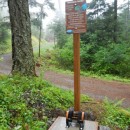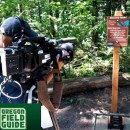Gorge Weeds – Early Detection Rapid Response
The Columbia River Gorge draws thousands of visitors a year for hiking, fishing, boating, bird watching, wind surfing, and many other activities. Along with stunning views and dramatic geology, visitors can see a variety of wildlife and wildflowers in the Gorge, but unfortunately many of the blooming species they see while enjoying this National Scenic Area are unwelcome weeds. Some species in particular have been targeted for early detection efforts, to help prevent their spread before they can become too established here.
Land managers on both sides of the Columbia River have banded together to form the Columbia Gorge Cooperative Weed Management Area (CGCWMA). The group includes representatives of state and federal agencies, non-profits, universities and regional landowners who work together to protect the Gorge from invasive species.
As a partner in the CGCWMA, the Hood River SWCD helped apply for and manage a grant from National Fish and Wildlife Foundation (NFWF) for a two-year “Early Detection & Rapid Response (EDRR)” project to target work on target weeds in the Gorge from several angles. The Hood River SWCD hired local botanist, Emily Stevenson to implement the EDRR project in 2011 and 2012.
 Armed with weather resistant gear and clothing, Emily spent the two summers traveling throughout the Gorge by boat, car, and on foot to seek out locations of early invaders and established weed patches. A total of 47 sites (over 150 miles of trail) in and around the Columbia Gorge National Scenic Area were surveyed for target weed species including false brome (Brachypodium sylvaticum), garlic mustard (Alliaria petiolata), and knotweed (Polygonum spp.). Several hundred new observations were made in addition to collecting existing data. All findings were reported to both the appropriate state weed database (iMapInvasives in Oregon) and the land manager.
Armed with weather resistant gear and clothing, Emily spent the two summers traveling throughout the Gorge by boat, car, and on foot to seek out locations of early invaders and established weed patches. A total of 47 sites (over 150 miles of trail) in and around the Columbia Gorge National Scenic Area were surveyed for target weed species including false brome (Brachypodium sylvaticum), garlic mustard (Alliaria petiolata), and knotweed (Polygonum spp.). Several hundred new observations were made in addition to collecting existing data. All findings were reported to both the appropriate state weed database (iMapInvasives in Oregon) and the land manager.
In addition to the surveys and data reporting, seven “Weed Watcher” workshops were held for a total of 163 attendees providing training on EDRR practices and noxious weed identification. A field guide to the “Worst Weeds of the Columbia Gorge” was developed and published.
 Boot brushes and signage were installed at 25 key trailheads in the Columbia River Gorge to encourage visitors to clean their boots before and after hiking. (View a map of the boot brush sites in the east and west ends of the Gorge). This helps minimize the spread of weed seeds through the sensitive and unique habitats found in the Columbia River Gorge National Scenic Area. Visitors can report invasive species sightings at www.oregoninvasiveshotline.org, or can use their smart phones to report observations directly to iMapInvasives. Engaging both land managers and visitors to the Gorge will ensure the protection of its natural beauty and biodiversity for generations to come.
Boot brushes and signage were installed at 25 key trailheads in the Columbia River Gorge to encourage visitors to clean their boots before and after hiking. (View a map of the boot brush sites in the east and west ends of the Gorge). This helps minimize the spread of weed seeds through the sensitive and unique habitats found in the Columbia River Gorge National Scenic Area. Visitors can report invasive species sightings at www.oregoninvasiveshotline.org, or can use their smart phones to report observations directly to iMapInvasives. Engaging both land managers and visitors to the Gorge will ensure the protection of its natural beauty and biodiversity for generations to come.
 The project was a huge success, even attaining a television spot on the Oregon Public Broadcasting show Oregon Field Guide. You can watch the video here. Now that the CG-CWMA has baseline data as well as new observations and survey results, the team can better prioritize future treatment and survey efforts and can easily share data between all partners. For more information about this project contact Jordan Kim.
The project was a huge success, even attaining a television spot on the Oregon Public Broadcasting show Oregon Field Guide. You can watch the video here. Now that the CG-CWMA has baseline data as well as new observations and survey results, the team can better prioritize future treatment and survey efforts and can easily share data between all partners. For more information about this project contact Jordan Kim.


 As one of the largest conservation funders in the world,
As one of the largest conservation funders in the world, 
